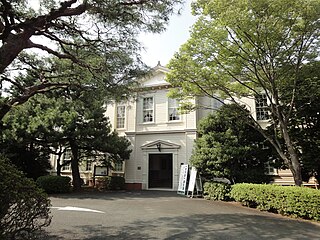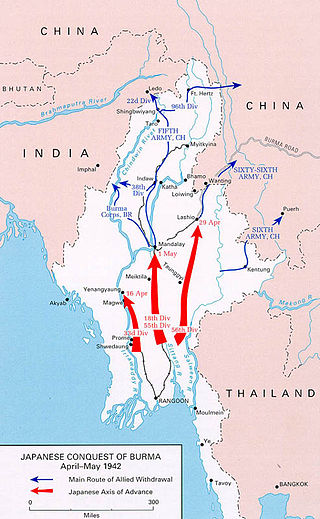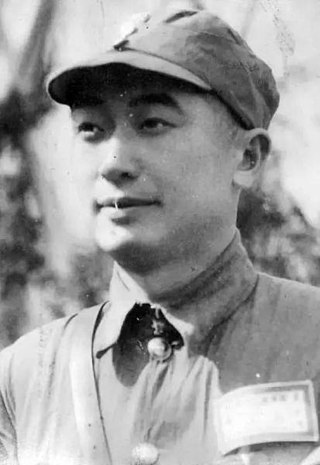
The National Revolutionary Army, sometimes shortened to Revolutionary Army (革命軍) before 1928, and as National Army (國軍) after 1928, was the military arm of the Kuomintang from 1925 until 1947 in China during the Republican era. It also became the regular army during the KMT's period of party rule beginning in 1928. It was renamed the Republic of China Armed Forces after the 1947 Constitution, which instituted civilian control of the military.

The 5th Infantry Division is an infantry division of the Indian Army. It was raised during the second world war and fought in several theatres of war and was nicknamed the "Ball of Fire". It was one of the few Allied divisions to fight against three different armies - the Italian, German and Japanese armies.

The 200th Division was the first mechanised division in the National Revolutionary Army. It was created in 1938 by General Du Yuming, who was also its first commander. Its first action was against the Japanese 14th Division in the Battle of Lanfeng.
This article deals with the chronology and development of Chinese armoured forces from 1927 to 1945.
The following is the order of battle of the forces involved in the Battle of Shanghai, during the opening stages of the Second Sino-Japanese War.

The 15th Division was an infantry division in the Imperial Japanese Army. Its tsūshōgō code name was the Festival Division, and its military symbol was 15D. The 15th Division was one of four new infantry divisions raised by the Imperial Japanese Army in the closing stages of the Russo-Japanese War (1904–1905). With Japan's limited resources towards the end of that conflict, the entire IJA was committed to combat in Manchuria, leaving not a single division to guard the Japanese home islands from attack. The 15th Division was initially raised from men in the area surrounding Nagoya under the command of Lieutenant General Okihara Kofu.
The Battle of Kunlun Pass was a series of conflicts between the Imperial Japanese Army and the Chinese forces surrounding Kunlun Pass, a key strategic position in Guangxi province. The Japanese forces planned to cut off Chinese supply lines linking to French Indochina, but the Chinese forces managed to fight off the attacks.
Battle of Yunnan-Burma Road was the name of the Chinese intervention to aid their British allies in the 1942 Burma Campaign. Its forces were composed of the Fifth, Sixth and Sixty-sixth Army under the command of the Chinese Expeditionary Force in Burma, commanded by Lt. General Joseph Stilwell, Lt. General Luo Zhuoying was his executive officer.

The Battle of Yenangyaung was fought in Burma from 16 to 19 April 1942. As part of the Burma Campaign of World War II, the battle was fought between Chinese and British allied forces on one side and Japanese forces on the other. The battle took place in the vicinity of Yenangyaung and its oil fields.
The following units and commanders fought in the Battle of Lanfeng in May 1938.
The Battle of Tachiao, was the first clash in the Battle of Yunnan-Burma Road in the Burma Campaign of World War II and Second Sino-Japanese War.
The Battle of Toungoo was one of the key battles in the Battle of Yunnan-Burma Road in the Burma Campaign of World War II and Second Sino-Japanese War. The failure of the Chinese to hold the city of Toungoo opened up the route for the Japanese to make their lunge to Lashio around the allied flank and into the Chinese rear.
The 56th Division was an infantry division of the Imperial Japanese Army. Its call sign was the Dragon Division. It was formed on 10 July 1940 in Kurume, simultaneously with the 51st, 52nd, 54th, 55th, and 57th Divisions. The formation nucleus was the headquarters of the 12th Division. Its manpower came primarily from Fukuoka, Saga and Nagasaki prefectures. The 56th Division was initially assigned to the Kurume Mobilization District, under the command of the Western District Army.
The 55th Division was an infantry division of the Imperial Japanese Army during World War II. Its call sign was the "Sou" Division. It was formed on 10 July 1940 in Zentsūji, simultaneously with the 51st, 52nd, 54th, 56th, and 57th divisions. The formation nucleus was the headquarters of the 11th Division. Its manpower came primarily from the four prefectures of Shikoku Island. The 55th Division was initially assigned to the Central District Army.

The Japanese invasion of Burma was the opening phase of the Burma campaign in the South-East Asian theatre of World War II, which took place over four years from 1942 to 1945. During the first year of the campaign, the Japanese Army drove British Empire and Chinese forces out of Burma, then began the Japanese occupation of Burma and formed a nominally independent Burmese administrative government.
The Japanese 21st Army was an army of the Imperial Japanese Army during the Second Sino-Japanese War.
The following units and commanders fought in the Battle of Northern and Eastern Henan.

The Arakan campaign of 1942–1943 was the first tentative Allied attack into Burma, following the Japanese invasion of Burma earlier in 1942, during the Second World War. The British Army and British Indian Army were not ready for offensive actions in the difficult terrain they encountered, nor had the civil government, industry and transport infrastructure of Eastern India been organised to support the Army on the frontier with Burma. Japanese defenders occupying well-prepared positions repeatedly repulsed the British and Indian forces, who were then forced to retreat when the Japanese received reinforcements and counter-attacked.

The Battle of the Ch'ongch'on River, also known as the Battle of the Ch'ongch'on, was a decisive battle in the Korean War that took place from November 25 to December 2, 1950, along the Ch'ongch'on River Valley in the northwestern part of North Korea. In response to the successful Chinese First Phase Campaign against the United Nations (UN) forces, General Douglas MacArthur launched the Home-by-Christmas Offensive to expel the Chinese forces from Korea and to end the war. Anticipating this reaction, the Chinese People's Volunteer Army (PVA) Commander Peng Dehuai planned a counteroffensive, dubbed the "Second Phase Campaign", against the advancing UN forces.

Dai Anlan was a major general of the Republic of China. As commander of the 200th Division of the National Revolutionary Army, he distinguished himself in the Battle of Kunlun Pass and the Battle of Toungoo during the Second Sino-Japanese War and the Burma Campaign. He was wounded in battle while returning to China from Burma, and died in May 1942. He was posthumously promoted to lieutenant general by Chiang Kai-shek and awarded the Legion of Merit medal by US President Franklin D. Roosevelt.








